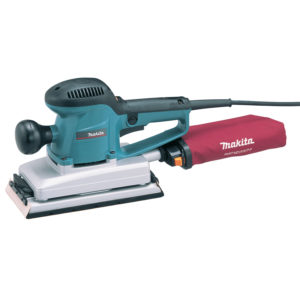Orbital Sanders
Protrade stock a number of orbital sanders from quality brands such as Festool, Mafell and Makita. An orbital sander is named as such because it utilises small orbits of its base to perform the sanding action. The size of the orbit can affect the speed of stock removal, with a rule of thumb being the larger the orbit, the faster the sanding process, albeit with reduced quality in finish. Orbital sanders require an abrasive to be attached to the backing pad and this is usually achieved in one of two ways. If the model of sander has abrasive retention clips the traditional method is to tear abrasive paper from a sanding roll or sheet and trap it in the clips. The tighter the abrasive is drawn over the backing pad the more positive contact the paper has with it, which helps to improve sanding efficiency. The term ‘half sheet’ sander comes from the size of abrasive paper required, to cover the backing pad, whilst allowing for enough excess material to be clamped by the clips at either end of the sander; hence half a sheet of sandpaper was required from a single piece of industry standard 230mm x 280mm abrasive paper. The same rule applies for ‘third sheet’ sanders. Although this system has worked for many years and continues to be used by many woodworkers it is not without problems. Orbital sanders are more popular for trades such as decorating because of the shape of the pad and the access they allow for sanding door panels and internal corners on skirting and floors. It’s worth noting that palm sanders are also an orbital sander but feature a smaller backing pad.
Protrade prioritises your productivity. Order before 5 pm and enjoy nationwide next-day delivery. Or, skip the wait and click and collect from any of our conveniently located Depots in Burton Upon Trent, Chesterfield, Derby, Mansfield, and Nottingham.
Showing 1 of 1 product
Loading filters please wait.





